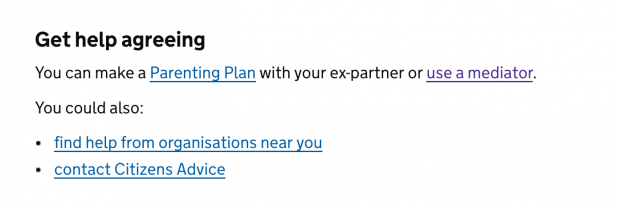The start of the year is sometimes known as Divorce January due to the rise in enquiries about separation that happens after the holidays.
This made it the right time for us to go live with new, improved content on GOV.UK aimed at helping couples that are breaking up.
Working in a complex world
As separation and family break-up is such a complicated area, it was important to work in the right way. With this in mind, we decided to:
1) Take an end-to-end, service design approach
Users don’t break their tasks down by government department or organisation and neither did we. We wanted to avoid silo thinking and consider the whole user journey, across website content, online services and tools, on GOV.UK and beyond.
2) Work as collaboratively as possible
As well as teaming up with content designers from Government Digital Service (GDS), we also worked with HM Courts and Tribunals colleagues, policy teams from Ministry of Justice (MOJ) and Department of Work and Pensions (DWP), with Cafcass and other organisations such as Citizens Advice.
Breaking up is hard to do
Our initial focus was to help parents make arrangements for their children. However, we soon realised that separation throws up a whole series of challenges that interconnect and overlap.
People’s initial concerns tend to be:
“Where will I live..?
How will I live..?
What about my job..?
What about the kids..?”
These concerns can often change quickly if there’s a new partner or a parent moves to another location.
Faced with so many tough questions at a difficult time, it’s little wonder users told us they really wanted help to understand their options.
What’s GOV got to do with it?
Although GOV.UK does not offer general help and advice, it is well known, well visited and trusted by users. This means it has an important part to play in helping separating couples and parents.
After detailed investigation, we found the content was:
- well-written but split across the website, making it hard for users to see all the tasks they needed to do
- linking to advice sites and tools in the right-hand column but users weren’t seeing or clicking the links
- helping users through court processes but not so good at explaining their options or offering any alternatives to court

Joining the dots, filling the gaps
Working with GDS content designers and our other partners, we planned and delivered a number of content improvements, including:
- A new page giving users a top-level overview of what’s involved in separation, linking out to the individual guides and services across GOV.UK.
- Expanding and updating 5 existing guides, including one for separating parents, to introduce new content around alternatives to court and answer new user needs.
- Improving signposting to help and self-service tools by placing them in the main body of content.

It’s a good start
One month on from launch and we’ve seen a large increase in users linking from GOV.UK to the featured sites and engaging with online tools. Compared with the same month the previous year:
- Sorting out Separation saw almost 30 times the number of visitors
- Parenting Plan saw over 7 times the number of visitors
- Citizens Advice saw 3 times the number of visitors.
… but there’s still work to do
The approach we’ve taken so far has been effective.
“The research MOJ had done around personas and user behaviours proved highly beneficial when it came to working on the content. The collaborative way of working allowed us to make out-of-court options clearer on GOV.UK and developed our relationship with MOJ." Steph Wilson, GDS content designer
We’re going to continue working in the same way with GDS to make further updates and improve the journey for users on GOV.UK.
As a team we’re also working with colleagues across government on a series of tools and services to help separating couples and families.
Subscribe to the blog for updates on our work or follow us on Twitter.

1 comment
Comment by Anne Barlow posted on
Glad to see this work is moving forward and has simplifed but informative content! The pages look much easier to follow.